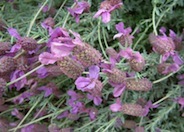
Common name:Sea Pink, Common Thrift
Botanical name:Armeria maritima
This clumping, grass-like perennial is native to many areas, including coastal California. Its flowers range from deep rose pink through white. -Monterey Bay Nursery

Common name:New Zealand Flax
Botanical name:Phormium tenax
New Zealand Flax is a large, bold plant with stiffly vertical, sword-like, green leaves that arise from its base. It should be grown under full sun for best color. Varieties will offer different growth habits and leaf color.

Common name:Dr. Hurd Manzanita
Botanical name:Arctostaphylos manzanita 'Dr. Hurd'
This is a large shrub with showy bark that reaches 8'-20' tall and wide. It has dark red bark, large pale green leaves and white to pink flower clusters that bloom from February to March.

Common name:Golden Breath Of Heaven
Botanical name:Coleonema pulchrum 'Sunset Gold'
Sunset Gold Breath of Heaven is a fine textured, low growing shrub to 10 in. high and wide with bright yellow foliage. It is excellent for rock gardens. It is drought tolerant. -Cornflower Farms

Common name:Otto Quast Spanish Lavender
Botanical name:Lavandula stoechas 'Otto Quast'
This round shrub will grow to about 3' high and has small, gray/green leaves with purple, lavender, and blue flowers that bloom in summer. More prostrate than its parent Lavandula stoechas.

Common name:Japanese Camellia
Botanical name:Camellia japonica
An evergreen shrub or small tree, the Camellia japonica can reach 6-15' depending on the variety. It is intended for growth in part sun to shade, with average to little summer watering when established. They make excellent container plants.
-Monterey Bay Nursery
In the natural world the endless cycle of birth, growth, decay, death and rebirth flows throughout the seasons. Plants die, leaves fall and new growth springs up in its place. Nothing is lost and the fallen leaves and dead plants decay into the soil, enriching it for the next generation of growth.
Click in the green box for more information
Designer:
Photographer: GardenSoft
Practice grass-cycling by leaving short grass clippings on lawns after mowing, so that nutrients and organic matter are returned to the soil.
Adjust sprinklers to avoid watering sidewalks and driveways.
Attract, or buy beneficial insects such as ladybugs and lacewings to control pest outbreaks in your garden.